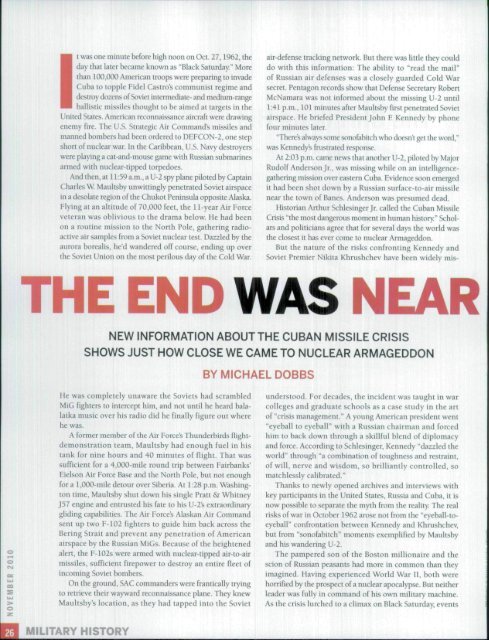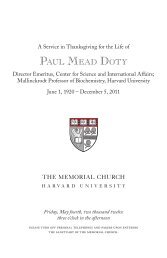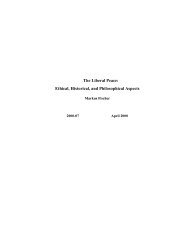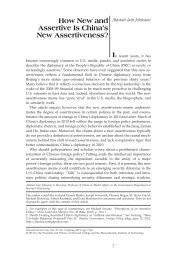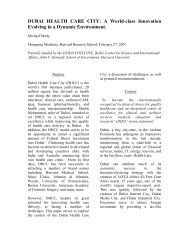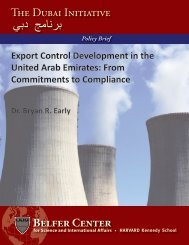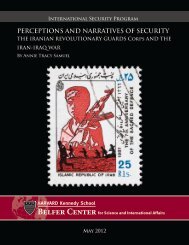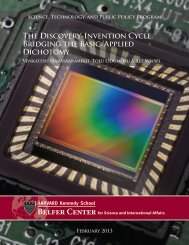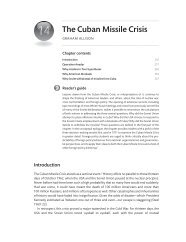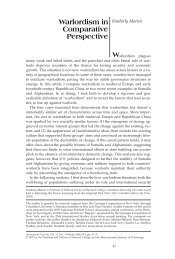THE END WAS NEAR
THE END WAS NEAR
THE END WAS NEAR
Create successful ePaper yourself
Turn your PDF publications into a flip-book with our unique Google optimized e-Paper software.
o<br />
It was one minute before high noon on Oct. 27,1962, the<br />
day that later became known as "Black Saturday" More<br />
than 100,000 American troops were preparing to invade<br />
Cuba to topple Fidel Castro's communist regime and<br />
destroy dozens of Soviet intermediate- and medium-range<br />
ballistic missiles thought to be aimed at targets in the<br />
United States. American reconnai.ssance aircraft were drawing<br />
enemy fire. The U.S. Strategic Air Command's missiles and<br />
manned bombers bad been ordered to DEECON-2, one step<br />
short of nuclear war. In the Caribbean, U.S. Navy destroyers<br />
were playing a cat-and-mouse game with Russian submarines<br />
armed with nuclear-tipped torpedoes.<br />
And then, at 11:59 a.m., a U-2 spy plane piloted by Captain<br />
Charles W. Maultsby unwittingly penetrated Soviet airspace<br />
in a desolate region of the Chukot Peninsula opposite Alaska.<br />
Flying at an altitude of 70,000 feet, the 11-year Air Force<br />
veteran was oblivious to the drama below. He bad been<br />
on a routine mission to the North Pole, gathering radioactive<br />
air samples from a Soviet nuclear test. Dazzled by tbe<br />
aurora boreahs, he'd wandered off course, ending up over<br />
the Soviet Union on the most perilous day of the Cold War.<br />
air-defense tracking network. But there was little they could<br />
do with this information: The ability to "read the mail"<br />
of Russian air defenses was a closely guarded Cold War<br />
secret. Pentagon records show that Defense Secretary Robert<br />
McNamara was not informed about tbe missing U-2 until<br />
1:41 p.m., 101 minutes after Maultsby first penetrated Soviet<br />
airspace. He briefed President Jobn E Kennedy by phone<br />
four minutes later.<br />
"There's always some sonofabitch who doesn't get the word,"<br />
was Kennedy's frustrated response.<br />
At 2:03 p.m. came news that another U-2, piloted by Major<br />
Rudolf Anderson Jr., was missing while on an intelligencegathering<br />
mission over eastern Cuba. Evidence soon emerged<br />
it had been shot down by a Russian surface-to-air missile<br />
near the town of Banes. Anderson was presumed dead.<br />
Historian Arthur Schlesinger Jr. called the Cuban Missile<br />
Crisis "the most dangerous moment in human history." Scholars<br />
and politicians agree that for several days the world was<br />
the closest it has ever come to nuclear Armageddon.<br />
But the nature of the risks confronting Kennedy and<br />
Soviet Premier Nikita Khrushchev have been widely mis-<br />
<strong>THE</strong> <strong>END</strong> <strong>WAS</strong> <strong>NEAR</strong><br />
NEW INFORMATION ABOUT <strong>THE</strong> CUBAN MISSILE CRISIS<br />
SHOWS JUST HOW CLOSE WE CAME TO NUCLEAR ARMAGEDDON<br />
He was completely unaware the Soviets had scrambled<br />
MiG figbters to intercept him, and not until he heard balalaika<br />
music over bis radio did he finally figure out where<br />
he was.<br />
A former member of tbe Air Force's Tbunderbirds fligbtdemonstration<br />
team, Maultsby bad enough fuel in his<br />
tank for nine hours and 40 minutes of flight. That was<br />
sufficient for a 4,000-mile round trip between Fairbanks'<br />
Eielson Air Force Base and tbe Nortb Pole, but not enough<br />
for a 1,000-mile detour over Siberia. At 1:28 p.m. Washington<br />
time, Maultsby shut down his single Pratt & Whitney<br />
J57 engine and entrusted his fate to his U-2's extraordinary<br />
gliding capabilities. The Air Force's Alaskan Air Command<br />
sent up two F-102 figbters to guide bim back across tbe<br />
Bering Strait and prevent any penetration of American<br />
airspace by the Russian MiGs. Because of the heightened<br />
alert, the F-102s were armed with nuclear-tipped air-to-air<br />
missiles, sufficient firepower to destroy an entire fleet of<br />
incoming Soviet bombers.<br />
On the ground, SAC commanders were frantically trying<br />
to retrieve their wayward reconnaissance plane. They knew<br />
Maultsby's location, as they had tapped into the Soviet<br />
\ MILITARY HISTORY<br />
BY MICHAEL DOBBS<br />
understood. Eor decades, the incident was taught in war<br />
colleges and graduate schools as a case study in the art<br />
of "crisis management." A young American president went<br />
"eyeball to eyeball" with a Russian chairman and forced<br />
him to back down through a skillful blend of diplomacy<br />
and force. Accorditig to Scblesinger, Kennedy "dazzled the<br />
world" through "a combination of toughness and restraint,<br />
of will, nerve and wisdom, so brilliantly controlled, so<br />
matchlessly calibrated."<br />
Tbanks to newly opened archives and interviews with<br />
key participants in the United States, Russia and Cuha, it is<br />
now possible to separate the mytb from the reality. The real<br />
risks of war in October 1962 arose not from the "eyeball-toeyeball"<br />
confrontation between Kennedy and Khrushchev,<br />
but from "sonofabitcb" moments exemphfied by Maultsby<br />
and his wandering U-2.<br />
The pampered son of the Boston millionaire and the<br />
scion of Russian peasants had more in cominon than they<br />
imagined. Having experienced World War II, both were<br />
horrified hy the prospect of a nuclear apocalypse. But neither<br />
leader was fully in command of his own mihtary machine.<br />
As the crisis lurched to a climax on Black Saturday, events
Photographed from a low-flying U.S. Navy<br />
patrol aircraft in November 1962, the Soviet<br />
freighter Anosov carries tarpaulin-shrouded<br />
ballistic missiles on her fore and aft decks.
CSI<br />
ae.<br />
LU<br />
CO<br />
threatened to spin out of control. Unable to effectively<br />
communicate with each other, the two leaders struggled<br />
to rein in the chaotic forces of history they themselves<br />
had unleashed.<br />
The countdown to Armageddon began on October 16,<br />
when Kennedy learned that Khrushchev had broken<br />
his promise not to deploy "offensive weapons" in<br />
Cuba—a U-2, piloted by Major Richard Heyser, had flown<br />
over the island two days earlier and taken photographs<br />
of intermediate-range Soviet missiles near the town of<br />
San Cristóbal. Kennedy branded the mercurial Russian<br />
leader "an immoral gangster," but the Americati presi-<br />
Soviet Premier Nikita Khrushchev and American President John F. Kennedy<br />
share a light moment after a meeting at the U.S. Embassy in Vienna,<br />
Austria, in June 1961. Just over a year later, the men, both veterans of<br />
World War II, would bring the world to the brink of all-out nuclear war.<br />
dent bore some responsibility for bringing about the crisis.<br />
His bellicose, but ultimately ineffective, attempts to get<br />
rid of Castro had provoked Khrushchev into taking drastic<br />
action to "save socialism" in Cuba. Kennedy imposed<br />
a military quarantine on the island and demanded the<br />
Soviets withdraw their missiles.<br />
By October 27—tbe 12th day of the crisis—the two superpowers<br />
were on the brink of war. The CIA reported that<br />
morning that five of the six Soviet R-12 missile sites were<br />
"fully operational." All that remained was for the warheads<br />
to be mated to the missiles. Time was obviously running out.<br />
The U.S.Joint Chiefs of Staff presented the president with<br />
a formal recommendation to bomb tbe Soviet missile sites.<br />
MLITA»V HISTORY<br />
A full-scale invasion of the island would follow within<br />
seven days. Marine units and the Army's 1st Annored Division<br />
would hit the beaches east and west of Havana, along a<br />
40-mile front, in an operation modeled after the ]uno 1Q44<br />
D-Day landings in France.<br />
It is impossible to tell what would have happened had<br />
Kennedy accepted the advice of Air Force General Curtis<br />
LeMay and the other joint chiefs. But several things are<br />
certain. The risks of a nuclear conflagration were extraordinarily<br />
high. And the full scope of the danger was not<br />
understood in Washington, Moscow or Havana. None of<br />
the main protagonists—Kennedy, Khrushchev or Castro—<br />
had tnore than a very limited knowledge of events unfolding<br />
on a global battlefield that stretched from the Florida Straits<br />
to the Bering Sea. In sotne ways. World War III had already<br />
begun—aircraft were taking fire, missiles were being readied<br />
for launch and warships were forcing potentially hostile<br />
subtnarines to surface.<br />
As Black Sattirday dawned, Castro wrote Moscow of<br />
his conviction that an American attack on the island was<br />
"almost inevitable" and would take place in the next 24 to<br />
72 hours. Unbeknownst to Kennedy, the Cuban leader had<br />
visited the Soviet embassy in Havana at 3 a.m. and petined<br />
an anguished telegram to Kbrushchev. If the "itnperialists"<br />
invaded Cuba, Castro declared, the Soviet Union should<br />
undertake a pre-emptive nuclear strike on the United States.<br />
In the meantime, he ordered his anti-aircraft defenses<br />
to begin firing on low-flying American reconnaissance<br />
planes. Castro declared that he and his comrades were<br />
"ready to die in the defense of our country" rather than<br />
submit to a Yanqui occupation.<br />
The Soviet cotnmander in Cuba, General Issa Pliyev,<br />
was also preparing for war. On his orders, a convoy of<br />
trucks carrying nuclear warheads moved out of the central<br />
storage depot at Bejucal, south of Havana, around midnight.<br />
By early afternoon, the convoy had reached the<br />
Sagua la Grande missile site in central Cuba, tnaking it<br />
possible for the Soviets to lob eight 1-megaton missiles<br />
at the United States. Pliyev also ordered the arming of<br />
shorter-range tactical nuclear missiles to counter a U.S. invasion<br />
of Cuba. By àawn a battery of cruise missiles tipped<br />
witb 14-kiloton warheads had targeted the U.S. naval<br />
base at Guantanamo Bay from an advance position just<br />
15 miles away.<br />
Kennedy was blissfully unaware of the nature of the<br />
threat facing U.S. forces poised to invade Cuba. Oti October<br />
23, the CIA estimated that the Soviets had between 8,000<br />
and 10,000 military "advisers" in Cuba, up from an earlier<br />
estimate of 4,000 to 5,000. We now know that the actual<br />
Soviet troop strength on Black Saturday was 42,822, a figure<br />
that included heavily armed combat units. Furthermore,<br />
these troops were equipped with tactical nuclear weapons<br />
intended to hurl an invading force back into the sea. Mc-<br />
Namara was stunned to learn, three decades later, that the<br />
Soviets had 98 tactical nukes in Cuba that Atnerican intelligence<br />
knew nothing about.
READY BLDGS<br />
U.S. reconnaissance<br />
aircraft, flying at<br />
high speed and<br />
often at low altitude,<br />
took thousands of<br />
images over Cuba,<br />
including, left,<br />
missile equipment<br />
at the port of Mariel;<br />
right, Soviet 11-28<br />
jet bombers at<br />
San Julian Airfield;<br />
and, below, a<br />
medium-range<br />
ballistic missile base.<br />
OXIDIZER VEHIC!'<br />
•MHHHl<br />
PROB HYDROGEN PEROXIDE TANKS<br />
ERECTOR ON LAUNCH PAD<br />
MISSILE READY BLDGS
o<br />
CM<br />
00<br />
BLACK SATURDAY. HOUR BY HOUR<br />
SATURDAY OCT. 271962<br />
• 12:38 a.m. Soviet SAM<br />
missile sites on Cuba activated,<br />
according to transmissions<br />
intercepted by USS Oxford.<br />
• 3 a.m. Fidel Castro visits<br />
Soviet embassy in Havana,<br />
wires Moscow urging<br />
Khrushchev to use<br />
nuclear missiles against<br />
U.S. if Cuba is invaded.<br />
• 4 a.m. U-2 piloted by<br />
Captain Charles W. Maultsby<br />
takes off from Eielson AFB<br />
en route to North Pole to<br />
monitor Soviet nuclear tests.<br />
• 5 a.m. Soviet nuclear<br />
cruise missiles arrive at<br />
launch position. 15 miles<br />
from Guantanamo naval base.<br />
• 6:45 a.m. U.S. Navy<br />
tracks Soviet freighter<br />
Grozny en route to Cuba.<br />
• 9:09 a.m. U-2 piloted by<br />
Major Rudolf Anderson takes off<br />
for mission over eastern Cuba.<br />
• 10:12 a.m. Anderson enters<br />
Cuban air space.<br />
• 10:18 a.m. Radio Moscow<br />
announces Khrushchev offer<br />
to withdraw missiles from<br />
Cuba in return for withdrawal<br />
of U.S. missiles in Turkey.<br />
• 11:19 a.m. Anderson is<br />
shot down, shortly after<br />
overflying Soviet missile<br />
positions near Guantanamo.<br />
• 11:30 a.m. Nuclear<br />
warheads arrive at Soviet<br />
missile base at Sagua la<br />
Grande in central Cuba after<br />
overnight journey from Bejucal.<br />
• U:59 a.m. Maultsby's Ü-2<br />
enters Soviet air space as a<br />
result of navigational error.<br />
III CIISIIIIl<br />
•II« SltBs.<br />
• 12:44 p.m. Soviet<br />
MiG fighters attempt<br />
to intercept Maultsby.<br />
• 1:28 p.m. Maultsby<br />
runs out of fuel.<br />
• 1:41 p.m. SAC informs<br />
Defense Secretary Robert<br />
McNamara that U-2 is<br />
missing off Alaska.<br />
• 1:45 p.m. McNamara<br />
informs Kennedy of missing U-2.<br />
• 2:03 p.m. McNamara<br />
informed that U-2 is<br />
missing over Cuba.<br />
• 2:25 p.m. Maultsby<br />
lands at Kotzebue. Alaska.<br />
• 3:02 p.m. Cuban<br />
radio announces that<br />
U.S. aircraft overflying<br />
Cuba will be fired upon.<br />
• 4:28 p.m. Cuban antiaircraft<br />
guns fire on Navy<br />
reconnaissance planes<br />
near San Cristobal.<br />
• 5:59 p.m. Navy drops practice<br />
depth charges on nuclear-armed<br />
Soviet submarine B-59.<br />
• 8:05 p.m. Robert Kennedy<br />
meets with Soviet ambassador<br />
Dobrynin. offers to withdraw<br />
U.S. missiles from Turkey<br />
"within four to five months"<br />
of Soviet puliout from Cuba.<br />
• 9:52 p.m. ß-59 surfaces<br />
without a fight.<br />
SUNDAY OCTOBER 28<br />
• 2 a.m. Khrushchev<br />
meets with Communist Party<br />
presidium; decides to withdraw<br />
Soviet missiles from Cuba.<br />
• 9 a.m. Radio Moscow<br />
announces withdrawal of<br />
Soviet missiles from Cuba.<br />
(All times Eastern;<br />
! s« I !
As the missile crisis deepened, U.S.<br />
forces at Guantanamo Bay on Cuba's<br />
southeast coast went on high alert.
As Maultsby glided across the skies of eastern Russia,<br />
a debate raged in the White House over how to respond<br />
to a new message from Khrushchev, delivered over Radio<br />
Moscow. The Soviet leader had offered Kennedy a deal:<br />
The Soviet Union would withdraw its nuclear missiles from<br />
Cuba if the United States agreed to remove its analogous<br />
missiles from Turkey Advisers urged the president to reject<br />
Khrushchev's offer, arguing that acceptance would destroy<br />
NATO, compromise the American negotiating position<br />
and confuse public opinion. Kennedy remained open to<br />
the proffered deal.<br />
"How else are we gonna get those missiles out of there?"<br />
he asked.<br />
Kennedy's decisions on Black Saturday were shaped<br />
by a lifetime of political and military experience,<br />
beginning with his service as a World War 11 U.S.<br />
Navy torpedo boat commander in the Pacific. One lesson<br />
he learned from World War II was that "the military always<br />
screws up." Another was that "the people deciding<br />
the whys and wherefores" had better be able to explain why<br />
they were sending young men into battle in clear and simple<br />
terms. Otherwise, Kennedy noted in a private letter,<br />
"the whole thing will turn to ashes, and we will face great<br />
trouble in the years to come." He was also influenced by historian<br />
Barbara Tuchman's 1962 book The Guns of August,<br />
which described how the great powers had blundered into<br />
World War I without understanding why. Kennedy did not<br />
want the survivors of a nuclear war to ask each other,<br />
"How did it all happen?"<br />
MILITARY HISTORY<br />
Bypassing his executive committee, or FxComm, the president<br />
sent his brother. Attorney General Robert F Kennedy,<br />
to meet Soviet Ambassador to the United States Anatoly Dobrynin<br />
at 8:05 p.m. on Black Saturday. "There's very little<br />
time left," the younger Kentiedy warned Dobt"ynin. "Events<br />
are moving too quickly." If the Soviet government dismantled<br />
its missile bases in Cuba, the United States would end<br />
the Cuba quarantine and promise not to invade the island.<br />
"What about Turkey?" Dobrynin asked.<br />
Tbe attorney general told the ambassador that the president<br />
was willing to withdraw the Ainerican Jupiter missiles<br />
from Turkey "within four to five tnonths" but added that the<br />
U.S. government would not make any public commitment to<br />
do so—that part of the deal would have to remain secret. Although<br />
Bobby Kennedy did not set a deadline for a response<br />
from Khntshchev, he warned that "we're going to have to make<br />
certain decisions within the next 12, or possibly 24, hours....<br />
If the Cubans shoot at our planes, we're goitig to shoot back."<br />
Like John Kennedy, Khrushchev had come to understand<br />
the liinits of crisis management. At 9 a.m. on October 28—<br />
the 13th day of the crisis—the Soviet premier broadcast<br />
another message over Radio Moscow, announcing the dismantling<br />
of the Cuban missile sites. He also expressed his<br />
concern about the overflight of the Chukot Peninsula by<br />
Maultsby's U-2. "What is this—a provocation?" he asked<br />
Kennedy. "One of your planes violates our frontier during<br />
this anxious time we are both experiencing, when everything<br />
has been put into combat readiness. Is it not a fact that<br />
an intruding American plane could be easily taken for a<br />
nuclear bomber, which might push us to a fateful step?"
-T':"sc*Tr:*- -"' ••'-•<br />
Citing national-security considerations, the U.S. Air<br />
Force has yet to release a single document on<br />
Maultsby's adventures. In the book One Minute<br />
to Midnight, this author was able to piece together his<br />
story from a family memoir, interviews with his fellow<br />
U-2 pilots and scraps of information discovered in other<br />
government archives. After switching off his engine,<br />
Maultsby glided for 45 minutes across the Bering Sea and<br />
was eventually picked up by the American F-102s. Maultsby<br />
performed a dead-stick landing on an ice airstrip near Kotzebue,<br />
on the westernmost tip of Alaska. Numbed from<br />
his 10 hour 25 minute ordeal, he had to be lifted out of<br />
Khrushchev's concession triggered the removal of most Soviet military<br />
hardware from Cuba. Top, Kasimov'is outbound with il-28 bomber<br />
fuselages. Above, USS Vesole escorts the missile-bearing Polzunov.<br />
the cockpit like "a rag doll." (Charles Maultsby died of<br />
cancer in 1998.)<br />
The "sonofabitch wbo never got the word" was fortunate<br />
to survive that day the White House called Black Saturday.<br />
So was the rest of humanity. (^<br />
Eor further reading, Michael Dobbs recommends his own<br />
One Minute to Midnight (Knopf 2008).
Copyright of Military History is the property of Weider History Group and its content may not be copied or<br />
emailed to multiple sites or posted to a listserv without the copyright holder's express written permission.<br />
However, users may print, download, or email articles for individual use.


